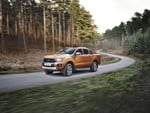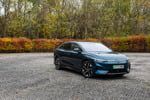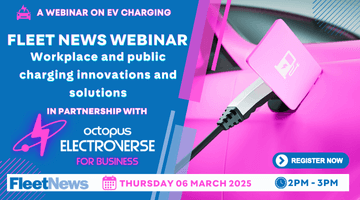Mercedes-Benz admits its “inconsistent” approach to fleet was an issue. Simon Harris looks at how attitudes have changed and why it now has realistic hopes of becoming a premium car leader

Mercedes-Benz has been in the ascendancy in recent years. In the past its appetite for fleet business had been patchy, and, unlike BMW and Audi, it was seen as a brand that was more focused on retail sales.
Even as recently as five years ago, Mercedes-Benz was a distant third in the premium car sales rankings in the UK, behind BMW and Audi.
A new strategy emerged in 2010, and the brand has achieved significant growth since. With a target of overtaking both Audi and BMW, which looks increasingly likely as we approach the end of 2016, the business of driving growth in fleet now falls to Rob East.
East became head of fleet for Mercedes-Benz passenger cars in July, having previously been national fleet sales manager. He joined parent company Daimler in 2009 and spent time at Smart and the Mercedes-Benz Driving Academy.
In his previous role, he led a team of strategic account managers to record-breaking fleet sales in 2016, and now East is set to smash those records again as head of fleet.
He does, however, ensure credit is given to his predecessors Nick Andrews and Sally Dennis for the brand’s huge improvement in performance in fleet and business sales.
“Before 2010 we were very inconsistent in fleet,” he says. “Post-2011 our doors were opened for business with fleets, and we ensured we were easy to do business with, behaved with consistency, and began a great product assault.
“In 2009 we had 20 different model lines. Now we have 30, and by 2020 we will have 40. There has been a massive shift in the market toward premium brands.”
The introduction of new models, expanding growth across a broader base, has allowed Mercedes-Benz to maximise volume while limiting its impact on residual values forecasts, ensuring demand for new model lines would also be created among used car buyers.
The revamped A-Class has much greater appeal than the previous generations, while the company has also added the CLA with four-door and ‘shooting brake’ estate versions, as well as the GLA crossover and B-Class using the same platform. A crossover based on the B-Class is also expected.
But although Mercedes-Benz has had its sights set on becoming the number one premium brand, it hasn’t been checking out the opposition and crunching numbers on the hoof for short-term tactical gains.
East says: “We work closely with customers in the leasing industry and there is unprecedented demand.
“As our product offering has broadened people who hadn’t previously considered Mercedes-Benz can increasingly find there is one suitable for them as a company car. Our overall volume is agreed with Daimler each year, and for us it’s about maximising our potential and continuing to grow.”
East says the transition from the previous A-Class to the current model defines what the brand has been trying to do as it sets about its ambition to grow, and the mix of models in each sales channel is also carefully measured when targets are set.
There has also been a transformation across the retailer network to ensure fleet and business customers using them felt as valued as a private owner.
East says: “We invested in ‘brand sharpening’, which manifests itself in the change from the old A-Class to the current A-Class, and our mission is to make Mercedes-Benz the default premium brand.
“We manage our channel mix very carefully to ensure we have the right balance, not just in fleet, but also retail, product planning and used cars.
“Our goal is to achieve simplicity, and to be open and transparent with our customers to help further develop our relationships. This has allowed us to create opportunities to talk to businesses we haven’t previously been able to.
“We aim to be number one in fleet and business sales and we are on course to achieve that. We have grown our direct sales programme and we are now supporting retailers targeting local businesses to establish a relationship either with the Mercedes-Benz brand or with their dealer.
“We want to provide the best customer experience whether the interaction is with the end-user company or with the driver. The company car driver wants the same experience with Mercedes-Benz as our retail customers have.”
East acknowledges that the road ahead might not be getting any easier, and there are a number of fresh challenges to face following the vote in June to leave the European Union, which has been followed by a devaluation of sterling against other currencies created by uncertainly in the markets.
“The platform created by Nick Andrews and Sally Dennis is a robust one,” he says, “But we don’t take things for granted. We are moving into uncharted territory. Post-Brexit our message is ‘business as usual’. We have a clear road map that has been agreed with the dealer network.
“Daimler is a global business and is exposed to the challenges of currency fluctuations across the world. There is no plan to take a knee-jerk reaction to the recent fall of sterling, and we aim to maintain a consistent pricing strategy.
“For now it’s too early to say this will be a lasting issue, and I don’t think prices alone influence consumer behaviour.
“But it’s about making the right product for the market at the right time, and all car manufacturers live and work in this environment.”
Mercedes-Benz offers a number of plug-in hybrid variants alongside petrol and diesel models, as well as developing other alternative fuel models.
East believes it is important to be able to offer a mix of powertrain options to ensure he doesn’t have to turn away customers. And, although some manufacturers have come up against a higher demand for plug-in cars than they originally anticipated, East says Mercedes-Benz is currently relaxed about the supply/demand equation in the UK.
“Our future powertrain strategy encompasses petrol, diesel, EV and plug-in hybrid,” he says. “We want to ensure customers have the broadest possible choice around powertrains to ensure the best fit for their requirements.
“We are comfortable with the level of supply and demand for our plug-in hybrid products. Our best-selling one is the C 350e, which has been very positively received.
“We are committed to plug-in hybrid vehicles and it is technology we are genuinely excited about. Our next plug-in hybrid variant will be the E 350e, which is coming soon and has an order bank building.”
The E 350e is part of a new E-Class range introduced in 2016, with the saloon in the spring and estate late summer. It will also be offered as a raised, soft-roader in the All-Terrain variant, giving it a rival for the Audi A6 Allroad and Volvo V90 Cross Country, and maintaining the strategy of increasing sales through new model lines.
East says: “The new E-Class has been positively received. I think it’s a tour de force and sensationally good.
“The diesel can achieve mid-60s mpg and the level of interior quality has moved up from the previous version. All future products will follow this template for interior quality and design.”
















Login to comment
Comments
No comments have been made yet.